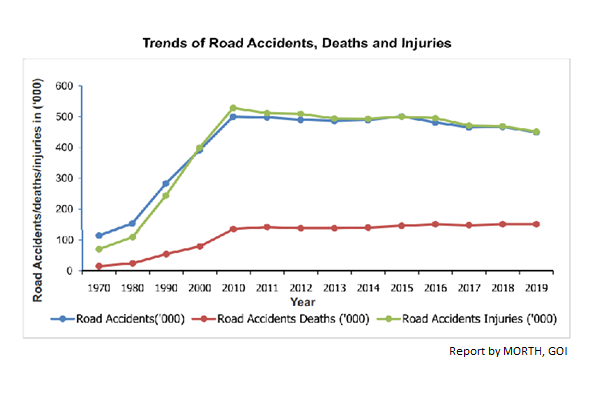Vision Based Driver Monitoring System: Ushering into an era of safer road travel.
According to a report of the World Bank, India accounts for 11% of global death in road accidents – highest in the world. In 2019, a total of 449,002 road accidents were reported of which 151,113 were fatal.
Apart from seat belt violations, mobile phone usage by drivers is an important contributor to accidents. National and State highways account for nearly 60% of road fatalities. This includes Truck and Bus Drivers on long distance routes. Sleep deprivation and alcohol abuse are contributors apart from various other factors.
A study by the Central Road Research Institute (CRRI) found that 40% of highway accidents occur due to drivers dozing off. Driver Monitoring Systems can play a crucial role in reducing a significant number of road mishaps.
As per the data published on the website of Ministry of Road Transport and Highways, the trends of road accidents, injuries and deaths in India is as follows:
What does a typical Driver Monitoring System Look Like?
A standard driver monitoring system typically takes input from raw data or images from a camera i.e., ocular input and provides it to the image/signal processing software. This software extracts PERCLOS (Percentage closure/opening of eyelids) and gaze from the raw data and analyses it to determine whether driver is drowsy / awake.
The diagram above shows the basic architecture of a standard driver monitoring system.
Components and Software Support
DMS is made up of technological and critical components. Critical components as you can see from the image above are:
Hardware (Sensors) – Cameras for detecting eye movements, gaze, mobile phone usage, drowsiness, distraction etc. Advanced systems have sensory inputs such as pulse/ heart rate monitoring smart watches, seat sensors and other such trackers, alerts and assistance systems.
Softwares for feature extraction and data analysis
Industry pioneer, Australian company, Seeing Machines is collaborating with Qualcomm to enhance its technology stack. Its Guardian system, an aftermarket DMS for trucks has come into the spotlight in the Covid-19 pandemic due to heightened demand for delivery and trucking services. There are other companies like Mobileye (https://www.mobileye.com/) who provide the complete driver monitoring system which directly gives output on the vehicle CAN bus.
In India, companies like Hi-Tech Robotic Systems have supplied Novus Aware technology to truck manufacturers as an industry first.
It can be seen that there are some companies who are working towards a complete solution whereas there are some companies like Phasya, who specialise in only the second layer of the DMS software. By using such specific solutions DMS manufacturers can reduce the number of false positives and negatives significantly.
Improvements and Complexities
Driver Monitoring Systems are becoming more nuanced and complex due to increasing number of monitoring parameters and requirement for accurate detection of driver state. Reducing false positives and false negatives is an important goal. The highest technical barrier before application of vision-based DMS technology is its performance in high or low light which may lead to all white or all black images, respectively. The automotive industry and stakeholders are facing several challenges in the development and validation of DMS. Though the complexity of the system is increasing, it is imperative to keep it affordable to encourage wider user adoption.
Expectations of the automotive technology sector to merge DMS and OMS (occupant monitoring systems) and eventually the movement towards autonomous vehicles will likely keep technology developers busy in years to come.
Global Regulatory Framework fully supports DMS
The European New Car Assessment Program (Euro NCAP) currently grants a vehicle points toward a 5-star rating for including DMS. Regulation (EU) 2019/2144 of the European Parliament and of the Council has mandated driver drowsiness and attention warning (DDAW) systems for all new type- approved motor vehicles of categories M and N from 6 July 2022 and from 7 July 2024 for all new vehicle registrations. DDAW systems assess the driver’s alertness through vehicle systems analysis and provide a warning to the driver as and when required.
India has a track record of following EU regulations with a lag of a year or two.
India has signed Brasilia Declaration Pledge in 2015 and committed to cutting down road deaths by 50% in the country by 2020 but has since revised the timeline to 2030.
For want of an Indian New Car Assessment Program (Indian NCAP), the international watchdog Global NCAP will continue ‘Safer Cars for India’ campaign at least till 2023. This project is mainly for testing and rating cars on Indian roads for their safety features.
Since 2018, the Ministry of Road Transport and Highways in India, has repeatedly shared the government’s plan to make ADAS features such as driver drowsiness detection, electronic stability control (ESC), adaptive cruise control, etc. mandatory in upcoming cars. While the jury is still out regarding an India NCAP, additional safety features like ESC, AEB (Autonomous Emergency Braking) are set to be mandatory by 2023, for vehicles sold in India.
Opportunities to contribute to Indian Road Safety
Working towards zero fatalities is an important milestone of future mobility. It is being pursued by legislators, automotive suppliers and OEMs across the globe.
In India, there is still a lack of wireless connectivity networks outside urban and semi-urban areas as well as other infrastructural challenges. Indian market also continues to be price sensitive. However, the pull from consumer side and the push from car makers as well as policy makers are indicating faster movement in ADAS, currently in its infancy in India. Current industry players in ADAS market viz. Robert Bosch, Continental Corporation India, Denso India, HELLA India, Delphi Automotive, Mando Automotive, Wabco India, and Infineon Technologies are trying to optimise performance through a combination of cost-effective sensors, radars, cameras, and integrated machine learning capabilities. This has created a hunting ground for key global suppliers to increase their foothold and gain first-mover advantage by forging strategic alliances with domestic suppliers, OEMs, and IT companies.
The passenger car segment is expected to be the largest during the forecast period. Features such as electronic stability control and automatic emergency braking have been considered in the Phase I.
As per the Prescient and Strategic Intelligence report, following technologies will see increasing penetration in the APAC market, increasing by 2030 and Indian automotive market is the fastest growing market in this region. Following are some of the technologies witnessing the traction :
- Tire-Pressure Monitoring System (TPMS)
- Drowsiness Monitoring System (DMS)
- Parking Assist System
- Adaptive Cruise Control System (ACCS)
- Blind Spot Detection System (BSDS)
- Lane Departure Warning System (LDWS)
As per a report by Markets & Markets, many ADAS players are already working towards introducing Driver Monitoring Systems. This will also speed up the availability and hence usage of these technologies by OEMs.
We expect to see a lot of changes in the Indian automotive market due to these advances in vision-based driver monitoring systems. To know more, write to me at sudhir.nerurkar@quanzen.com




